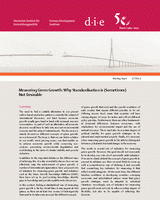Measuring green growth: why standardisation is (sometimes) not desirable
Stepping, Katharina M. K. / Jana StoeverBriefing Paper 17/2014
Bonn: German Development Institute / Deutsches Institut für Entwicklungspolitik (DIE)
The need to find a suitable alternative to our present carbon-based production pattern is currently the subject of international discussion, not least because economic growth usually goes hand in hand with increased resource consumption. As part of such an alternative, all economic decisions would have to take into account environmental concerns and the value of natural assets. The discussion is mainly focused on different concepts of green growth, now a buzzword. The hope is that we can find a solution to our world's most pressing issues, one that enables us to achieve economic growth while conserving ecosystems, preventing environmental degradation and contributing to the aims of climate stability and poverty reduction.
In addition to the important debate on the different ways of achieving this, it is also essential to discuss how we can effectively map the achievement of green growth. A number of international organisations have proposed sets of indicators for measuring green growth, and initiatives such as the Green Growth Knowledge Platform (GGKP) have been set up to pool existing knowledge, identify gaps in knowledge and provide a platform for discussion.
In this context, finding a standardised way of measuring green growth is far less trivial than it may appear at first glance, as there are at least two sources of heterogeneity that need to be taken into account: the different concepts of green growth that exist and the specific conditions of each country that require different priorities to be set. Differing income levels mean that countries will have varying degrees of scope for action and will set different policy priorities. Furthermore, there are often fundamental structural differences between economies, with implications for environmental impact and the use of natural resources. There must also be a certain degree of political stability for green growth strategies to be planned and implemented properly. Finally, it is necessary when measuring green growth to (be able to) distinguish between cyclical and structural changes in the economy.
This results in several sets of indicators for measuring green growth. However, the goal should not necessarily be to develop one sole set of universally valid indicators.
If we are to clearly delimit the concept of green growth to prevent its arbitrary use, then we need firstly to come up with a comprehensive way of defining it and secondly find overarching key indicators for measuring it that reflect central categories. At the same time, the different baseline conditions in developing countries, emerging economies and industrialised nations mean that green growth strategies must be adapted to individual situations. Accordingly, sets of indicators for measuring green growth need not only to allow a certain degree of flexibility, but also to be capable of reflecting this diversity.


